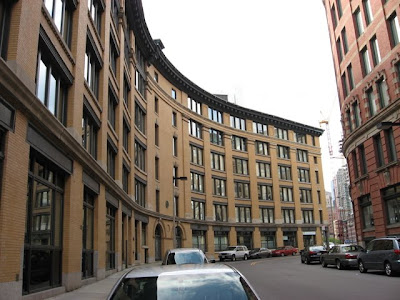I knew the factory was somewhere near the intersection of Summer and Melcher Streets, and right behind Melcher are two streets called Necco St. and Necco Ct. We located buildings on three of the four corners of that intersection that looked like the right era. We walked around, took pictures, and left. In the car on our way to find a bathroom and get something to eat, I was trolling the internet on my iPhone (something I seem to do pretty regularly these days!) and found a December 2008 document from the City of Boston entitled "The Fort Point Channel Landmark District Study Report." One of the many exciting facts contained in that report was a detailed description of the architecture of the Necco building, and its street address (253 Summer and 11-37 Melcher).
 It turns out that the original factory building was a gorgeous, curving yellow brick building on Melcher that we had seen on our visit, but immediately rejected as being too elegant for a factory. Who knew? The buildings immediately behind it (which we had guessed were part of the Necco complex on our first visit, located as they were on 5 and 6 Necco Court) were also built for Necco, and connected to each other and to the main building by the four-storey green connectors you see in the photos below. However they were not there in 1905--they were constructed in 1907.
It turns out that the original factory building was a gorgeous, curving yellow brick building on Melcher that we had seen on our visit, but immediately rejected as being too elegant for a factory. Who knew? The buildings immediately behind it (which we had guessed were part of the Necco complex on our first visit, located as they were on 5 and 6 Necco Court) were also built for Necco, and connected to each other and to the main building by the four-storey green connectors you see in the photos below. However they were not there in 1905--they were constructed in 1907.

Note that the back of the Melcher Street building (which you can see at the right in the above photos) is red brick with smaller windows--not as fancy as the front! None of the buildings is identified with any kind of signage (at least that we could see) to indicate that this was the site of the former Necco factory. And to further complicate the issue, many of the buildings bore a sign identifying the year of construction and a B.W.Co. logo. The photos below are of the sign on the building that turned out to be the 1902 Necco factory.


It was actually the B.W.Co. sign that led me to the research that led me to the report that led us back to the right building. It turns out that the Boston Wharf Co. was a huge commercial development operation that built most of the buildings in the Fort Point Channel District.
According to the report:
The Fort Point Channel Landmark District (FPCLD) encompasses roughly 55 acres across the Fort Point Channel from downtown Boston. This area, including the land, was entirely developed by a single corporation. . . .The Boston Wharf Company initially specialized in the storage of sugar and molasses, and gradually expanded its interests to become a major developer of industrial and warehouse properties served by ships docking in Boston Harbor, and by the railroad. The Boston Wharf Company laid out and constructed streets which they named for company officers and prominent tenants, parceled out lots, and erected nearly all of the buildings in the FPCLD from the designs of their own staff architects.
 The last photo in this post is a shot of the Necco factory taken from the Summer Street bridge. It shows the side of the Necco building and Fort Point Channel itself, and you can see the Gillette factory site just behind the smokestack on the right side of the photo. (Gillette is still there today--having surrounded what I think is their original 1906 factory with many additional buildings over the years.)
The last photo in this post is a shot of the Necco factory taken from the Summer Street bridge. It shows the side of the Necco building and Fort Point Channel itself, and you can see the Gillette factory site just behind the smokestack on the right side of the photo. (Gillette is still there today--having surrounded what I think is their original 1906 factory with many additional buildings over the years.) Necco and Gillette took advantage of their location on the water, and right near the brand new South Station railyard, to ship their products nationally and internationally.
The American Sugar Refining Co. also built a plant in the Fort Point Channel area in 1902 to manufacture Domino sugar. Probably not a coincidence that Necco was located hard by the sugar factory!
Today the Boston HarborWalk runs through the basement of the old Necco building, connecting the waterfront along the more inland part of the channel with the area around the Courthouse Plaza and beyond.
The American Sugar Refining Co. also built a plant in the Fort Point Channel area in 1902 to manufacture Domino sugar. Probably not a coincidence that Necco was located hard by the sugar factory!
Today the Boston HarborWalk runs through the basement of the old Necco building, connecting the waterfront along the more inland part of the channel with the area around the Courthouse Plaza and beyond.